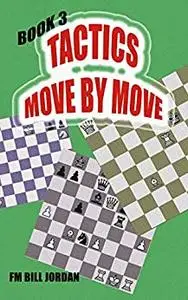Tactics Move by Move: Book 3 by FM Bill Jordan
English | 2020 | ISBN: N/A | ASIN: B083QCXRJC | 832 pages | EPUB | 4.59 Mb
English | 2020 | ISBN: N/A | ASIN: B083QCXRJC | 832 pages | EPUB | 4.59 Mb
This is Book 3 of a series of 5 books.
The series includes a series of puzzles to be solved. There are different levels of difficulty. Most puzzle books give a position and then a line of play as the answer. This is different in that you need to find each move of the answer, move by move.
Note that Look Inside removes page breaks, the full Kindle version has page breaks before moves are shown.
Why learn tactics?
The most important skill in chess is tactical skill. The stronger the player, the faster they can see tactics.
There is a good correlation between how quickly a player sees tactics and their rating.
There are several ways in which tactics help your Chess skill.
- You can checkmate, win material, queen a pawn or draw a weaker position with tactics.
- Seeing your opponent's tactics helps prevent them from happening.
- You learn to recognise positions that are tactically weak. This means you can reduce your opponent's tactical chances.
- You learn to recognise positions that are tactically strong. This means you can increase your tactical chances.
I am an experienced Chess master and Chess coach. I have read many tactics books, and grew up on books like Fred Reinfeld's 1001 Checkmates and 1001 Winning Sacrifices. All the strong players I knew in those days had worked through quite a few tactical puzzles.
Move by Move
You are only expected to find one move at a time, just like in a real game. This is different from most puzzle books where you are given an entire line of play as the answer.
Order of Difficulty
Positions at the start of Book 1 are suitable for novices, while positions in Book 5 are challenging enough for strong club players.
Avoiding Blunders
A point has been made you may only have a few tactical opportunities per game.
However, almost every move you have the chance of making a tactical blunder.
Tactical skill is invaluable in checking whether a move is safe or not, before you play it!
How difficult should positions be?
Easy positions means you will get through more positions and become familiar with more themes.
Difficult positions helps develop the ability to calculate variations in complicated positions.
I prefer the first approach based on my coaching experience.
Its the easier and more efficient approach.
Comments about notes
Here are explanations for some of the notes. Mating on the file or mates on the file, typically mean it will be mate soon after one or more useless blocking moves. The same applies to mating on the rank or diagonal.
A contact check is when a piece is one square away from the king. If the checking piece is defended a contact check is often strong. Queen contact checks tend to be especially strong.
A discovered check often wins material.
A double check forces the king to move.
Notes sometimes refer to tactical devices such as pins, skewers etc. There is more information about tactical ideas in my book Tactical Patterns Made Easy.
The notes are written are in a way to demonstrate how different types of moves fit together.
Enjoy the positions and have fun!
Other BooksYou can view my author page billjordanchess on Amazon. Some of my other books include :
- Chess Basics Made Easy.
- Chess Concepts Made Easy.
- Tactical Patterns Made Easy.
- Opening Moves Made Easy.
- Opening Strategy Made Easy.
- How to Write a Chess Program and other books on computer chess.
- Optimise your Chess Thinking.
- Play Fast, Positionally and Accurately.
- A series called Tactics Move by Move.
- A series called Endgames Made Easy.
- A series called Play Like a World Champion.



